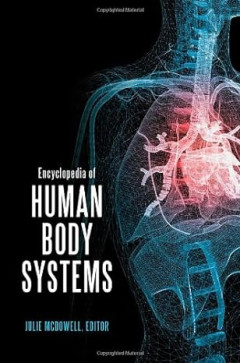Ditapis dengan

E-book Inside Animals (Invisible Worlds)
Describes the fascinating animal details that are too small for the unaided eye to see, and how these microscopic systems work to keep the animal alive and healthy.
- Edisi
- -
- ISBN/ISSN
- 9780761441953
- Deskripsi Fisik
- 50 halaman, ilus.
- Judul Seri
- -
- No. Panggil
- 573.9 GRE i

E-book Animals Up Close: Zoom in on the World's Most Incredible Creatures
- Edisi
- -
- ISBN/ISSN
- 9780756645137
- Deskripsi Fisik
- 98 halaman, ilus.
- Judul Seri
- -
- No. Panggil
- 571.1 SIW a
- Edisi
- -
- ISBN/ISSN
- 9780756645137
- Deskripsi Fisik
- 98 halaman, ilus.
- Judul Seri
- -
- No. Panggil
- 571.1 SIW a

E-Book Encyclopedia of Human Body Systems
This encyclopedia provides a concise yet comprehensive introduction to each of the systems of the human body, exploring all 11 organ systems of the human body: the circulatory, digestive, endocrine, integumentary, lymphatic, muscular, nervous, reproductive, respiratory, skeletal, and urinary systems. Each chapter includes detailed descriptions of important physiological processes, cell and tiss…
- Edisi
- -
- ISBN/ISSN
- 9780313391767
- Deskripsi Fisik
- 750 halaman
- Judul Seri
- -
- No. Panggil
- 612
E-book Animal Anatomy and Physiology 1
This e-book contains anatomy and physiology of an animal.
- Edisi
- -
- ISBN/ISSN
- -
- Deskripsi Fisik
- 418 hlm
- Judul Seri
- -
- No. Panggil
- 571.1 MAN a
E-book Plant Physiology
Water plays a crucial role in the life of plant. It is the most abundant constituents of most organisms. Water typically accounts for more than 70 percent by weight of non-woody plant parts. The water content of plants is in a continual state of flux. The constant flow of water through plants is a matter of considerable significance to their growth and survival. The uptake of water by cells gen…
- Edisi
- -
- ISBN/ISSN
- -
- Deskripsi Fisik
- 121 hlm
- Judul Seri
- -
- No. Panggil
- 571.2 ORD p
E-book Plant Physiology
The term cell is derived from the Latin cella, meaning storeroom or chamber. It was first used in biology in 1665 by the English botanist Robert Hooke to describe the individual units of the honeycomb-like structure he observed in cork under a compound microscope. The “cells” Hooke observed were actually the empty lumens of dead cells surrounded by cell walls, but the term is an apt one be…
- Edisi
- 3rd ed.
- ISBN/ISSN
- 0878938230
- Deskripsi Fisik
- 675 hlm
- Judul Seri
- -
- No. Panggil
- 571.2 TAI p
E-book Novel Plant Imagingand Analysis Water, Elements and Gas, Utilizing Rad…
Currently, powerful methods derived from molecular genetics have resulted in atendency to focus research on the molecular aspects of biology and tend to leavebehind important aspects of the activity of intact plants. However, the intact plantitself has high potential to integrate functions and to respond to diverse environ-mental conditions. To study the activity and development of living plant…
- Edisi
- -
- ISBN/ISSN
- 9789813349926
- Deskripsi Fisik
- 230 hlm
- Judul Seri
- -
- No. Panggil
- 571.2 NAK n
 Karya Umum
Karya Umum  Filsafat
Filsafat  Agama
Agama  Ilmu-ilmu Sosial
Ilmu-ilmu Sosial  Bahasa
Bahasa  Ilmu-ilmu Murni
Ilmu-ilmu Murni  Ilmu-ilmu Terapan
Ilmu-ilmu Terapan  Kesenian, Hiburan, dan Olahraga
Kesenian, Hiburan, dan Olahraga  Kesusastraan
Kesusastraan  Geografi dan Sejarah
Geografi dan Sejarah